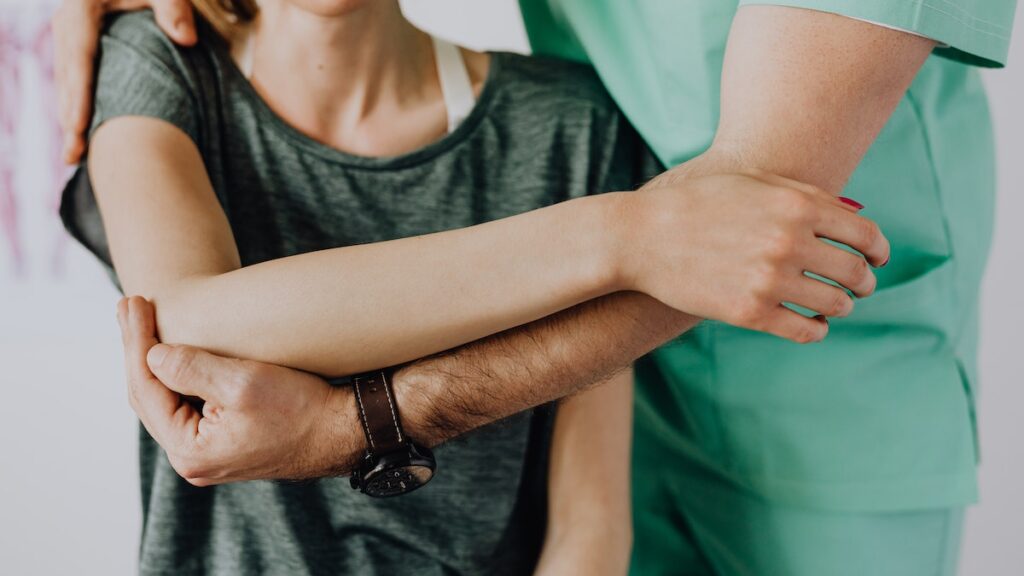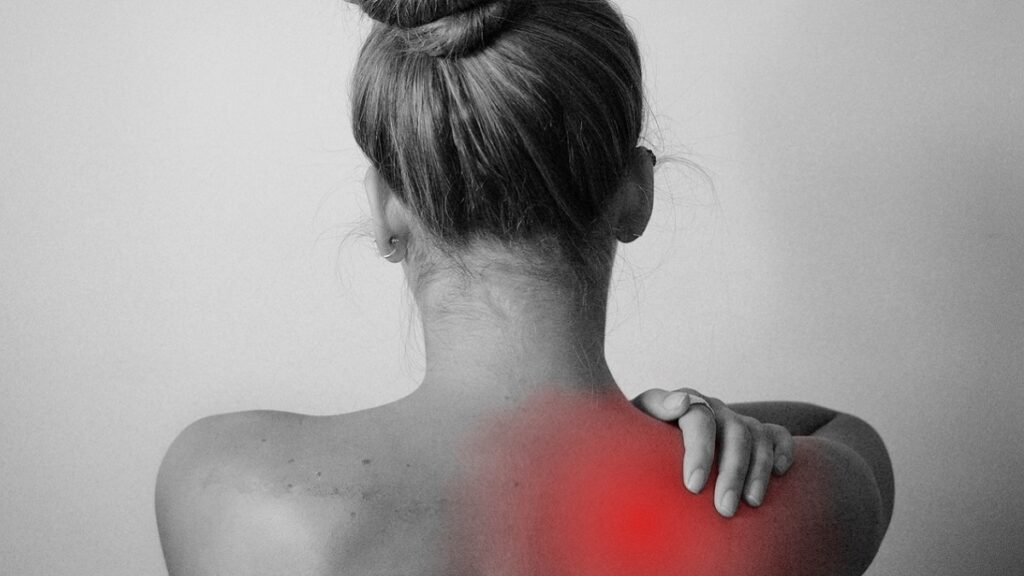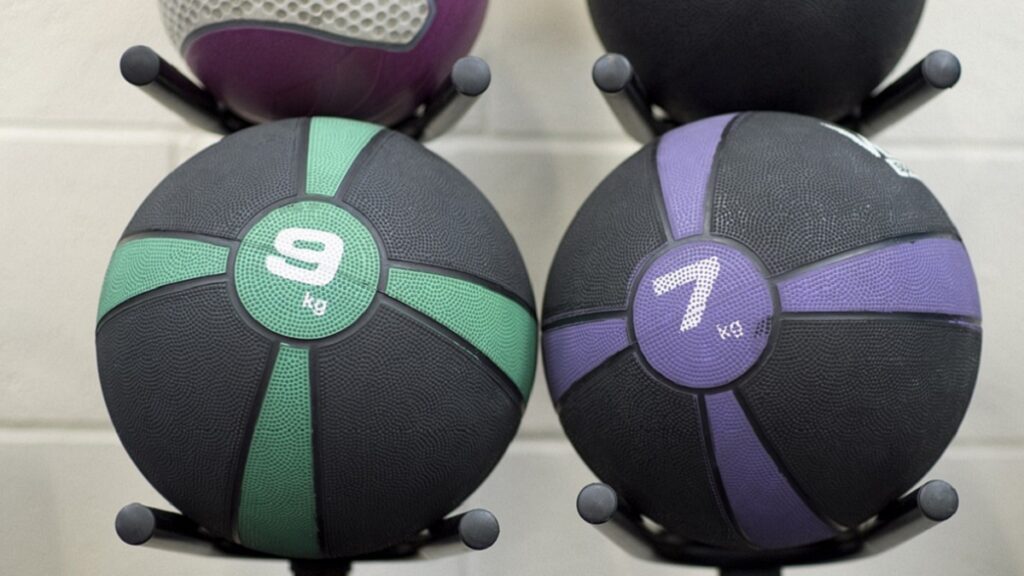The throwing shoulder loses internal rotation (IR) due to glenohumeral internal rotation deficit (GIRD). Although it results from complex shoulder rotations such as throwing motions, there are gird shoulder exercises to correct the internal rotation.
Gird shoulder exercises are sleeper stretch and prone shoulder extension. A gird shoulder lacks the normal internal rotation of the glenohumeral joint. So, you can use a gird test using a digital inclinometer to check if you have a gird. Gird may be painful or painless.
Although the cause of the altered range of motion is unknown, it’s a natural change that you can experience. Thankfully, this post will cover some efficient gird shoulder exercises and answer all your gird related questions.
What Does Gird Shoulder Mean?
A Glenohumeral Internal Rotation Deficit (GIRD) shoulder is a shoulder disorder that frequently affects a throwing athlete. It results from decreased internal rotation in the glenohumeral joint relative to the contralateral shoulder.
Some common symptoms of a gird shoulder are vagueness on your shoulder joint, pain or reduced strength when throwing. You can report to your physical therapist or a personal trainer if you experience such symptoms.
The thrower’s shoulder must strike a precise balance between flexibility and functional stability to allow excessive external rotation while being solid enough to minimize symptomatic humeral head subluxations.
This equilibrium is regularly thrown off, resulting in injuries like a dislocated shoulder. It can also develop for long-hour mobile phone and laptop users.
Gird Shoulder Exercises
Gird shoulder exercises return the shoulder’s internal rotation to normal. They aren’t vigorous but are very important for all overhead athletes. Here are some gird shoulder exercises you can embrace to keep your shoulders active and flexible.
Sleeper Stretch
The sleeper stretch is one of the best gird exercises. It’s also simple to perform at home. To perform the sleeper stretch:
- Stack your shoulders beneath you as you lay on the affected side. You can also use a pillow beneath your head
- Straighten your elbow so it’s parallel to your shoulder
- Point your fingers upward as you bend your arm at the elbow. Also, hold your arm in an L shape and keep it bent
- Point your forearm down toward the floor using the other hand.
- Next, press as deeply as you can and remember to keep the back of your shoulder, arm, or upper chest stretched out
- For 30 seconds, maintain the stretch.
- Perform 3–5 reps.
Ensure to do the sleeper stretch at least two or three times a week. A physical therapist might also ask you to do it more frequently based on your situation. Continue for a total of six weeks or until your recovery is complete.
Using a Towel to Sidelying External Rotation
The exercise is good for gird recovery since it’s soft but effective. Here’s how to do it.
- Start by bending your elbow 90 degrees as you lay on your side.
- Place a towel or a piece of cloth between your dominant arm and the side of your body.
- Hold that position and pull your shoulder blades back and down toward.
- Next, keep your arm against the towel and raise your shoulder blade while rolling it upward from your tummy toward the ceiling.
- Then lower your arm once again.
Each Direction, Scapular Clock Side Lying
The exercise is also an efficient side lying gird healing technique. To perform it, follow these steps closely.
- Laying on your side and having your intended arm in a neutral posture next to your torso is an excellent starting position.
- Then, raise your shoulder blade toward your head.
- Hold, then revert to the starting position.
- Afterwards, move your shoulder to the third position from your body’s front, hold it there, and return to the original position.
- Hold to that position as you lower your shoulder toward your waist, then raise it back to the starting position.
- Finally, bring your shoulder back to nine o’clock position, hold it there, and then return to your neutral position.
Prone Shoulder Abduction – End Position
That is among the best gird shoulder exercises to keep you going.
- Lay on your stomach and let your arm hang freely off the table, bed, or any other surface.
- Let the scapula squeeze both shoulder blades collectively as you raise your arm to the side with your thumb pointing downward.
- Maintain the scapular compression for five seconds as you gradually return the arm to its starting position.
Prone Shoulder Extension – End Position
Prone shoulder extension is one of the gird shoulder exercises that you should strive to perform correctly. You can do the opposite of prone shoulder abduction and still fight gird on your shoulder. Here are the steps.
- Lay on your stomach and let your arm swing freely off the surface (bed, table, etc.).
- Keep your elbow straight while you squeeze your shoulder blades tight (scap squeeze) (extended), and raise your arm, so it faces the ceiling.
- Maintain the scapular compression while lowering the arm gradually to the starting position.
Wall Sleeper Stretch
Standing against the wall, touch it with your shoulder and elbow. Keep your elbow bent 90 degrees, and position your body so that your shoulder is at a 45-degree angle to the wall. Put pressure on your wrist.
Your shoulder should start to stretch as you do these gird shoulder exercises. While at it, keep your body from slipping off the wall.
In addition to adjusting your posture throughout the day, these gird shoulder exercises to stretch and strengthen the posterior or rear of your shoulder muscles should help lessen pain and increase mobility.
What Is a Gird Test?
It’s necessary to know what a gird test is before starting the gird shoulder exercises. Well, a gird test is a physical therapy that assesses your shoulder to check if the internal rotation on your shoulder is normal. Gird tests are common among overhead athletes. That’s because they frequently engage their shoulders and arms. It can also be done medically or at home.
A sports doctor’s physical examination is a typical diagnostic. The doctor assesses internal and external rotation with the dominant shoulder abducted.
During the test, the doctor observes enhanced outward rotation but decreased internal rotation compared to the non-dominant shoulder. However, if there is a significant loss of internal rotation, GIRD causes most of the patient discomfort and poorer performance.
GIRD brings about shoulder impingement. Due to persistent excessive loading from frequent throwing, leading to posterior shoulder tightness and developing GIRD, a sport-specific adaptation. Regarding those adaptations, there are three major theories:
- The first assumes a posterior capsular tightness, occasionally followed by external rotation gains.
- According to theory two, GIRD begins to form as a bone adaptation during the early stages of overhead throwing.
- The third theory postulates that regular eccentric stress has caused the external rotators to swell.
How Do You Test Gird?
You can test for gird before embarking on gird shoulder exercises by measuring your internal rotation. How? By lying flat on your back with your arm at a 90° abduction angle to check for GIRD.
You can then use a digital inclinometer. According to researches, it’s the most accurate tool for determining shoulder range of motion.
So, while lying supine, bend the arm to 90 degrees, check for scapular mobility by palpating the coracoid process with the thumb of your hand, and then grip the arm at the wrist to cause internal rotation.
GIRD is present when there is a loss of more than 10° between the sides. However, a more than 10° variation in internal rotation between the sides may be insufficient to diagnose GIRD.
The complete range of movement from exterior to interior rotation is more intriguing. With less than a 10° variation between the sides, TROM (Total range of motion) typically ranges between 135 and 180 degrees.
The TROM, including both shoulders, may be the same even if you notice a side-to-side difference in internal rotation of more than 10 degrees, with the side that has less internal rotation showing a greater rise in external rotation.
Assess the total range of internal and external rotation in both shoulders to rule out GIRD if there is a discrepancy of more than 10°.
Is Shoulder Gird Painful?
Shoulder gird can be painful for some patients and lack pain in others. The typical symptom here is vagueness and lack of rotation on the throwing arm compared to the other. So is it a problem if I’m not in pain? You ask.
Well, even while a person with GIRD may not be in too much physical pain, addressing the condition’s biomechanical effects is still critical. Numerous different disorders in the shoulder can result from the physical abnormalities in the shoulder caused by GIRD.
The upper arm bone’s head moves forward in its socket due to tightness in the muscles and capsule behind the shoulder joint. The capsule in front of the shoulder is subsequently stretched as a result.
The shoulder labrum may tear over time due to this stretching of the anterior portion of the shoulder cap (also known as a “SLAP lesion”). Additionally, rotator cuff tears, shoulder joint instability, and various types of impingement in the shoulder have all been associated with GIRD.
In this throwing or overhead stance, the shoulder can physically shift over time if it’s repeatedly externally rotated to the end of the range:
- Too much outward and less internal rotation causes tightness in the shoulder joint’s capsule.
- The rotator cuff muscles on the back of your shoulder blade are constantly loaded (leading to more tightness through the back of your shoulder)
- In the early stages of overhead throwing, skeletal adaptations might also happen in the shoulder joint due to an excessive load.
What Causes Shoulder Gird?
The tightness of the posterior shoulder structures, which results in incorrect shoulder deceleration and recurrent trauma, is the root cause of GIRD. Throwing repeatedly, like throwing a ball, also causes GIRD.
The difficulties of throwing require special adaptations from throwers. The dominant shoulder in overhead athletes regularly demonstrates an increase in external rotation without a corresponding decrease in internal rotation, according to numerous papers published over the past 15 years.
However, the results are nearly identical if you combine ER and IR observations with the entire rotation motion.
How Long Does Gird Take To Heal?
It takes three to six months for a shoulder impingement to recover fully. Nevertheless, it may take up to a year for more severe cases to recover. On the other hand, it usually takes two to four weeks before you may resume your regular activities.
However, gird comes along with other infections such as labral and UCL ligament tears. In such a case, you’ll have to undergo surgery that takes a year to eighteen months to heal. Therefore, you must ensure you have a gird treatment program as soon as you notice any alarming symptoms.
Can Gird Cause Elbow Pain?
You’ll probably endure elbow soreness if you keep throwing while having a gird. Conversely, volleyball players, baseball players, and other throwing athletes are at risk for shoulder and elbow injuries due to Glenohumeral Internal Rotation Deficit (GIRD).
Stretching is advised to prevent gird. However, clinical assessments of internal rotation Range of Motion (ROM) do not distinguish between GIRD caused by muscular, capsular, or osseous adaptations.
Additionally, young athletes with elbow pain have worse GIRD than those who don’t. The two ailments are therefore connected.
What Causes Lack of Shoulder Internal Rotation?
Numerous reasons, including restricted muscle flexibility (stiff or tight soft tissues), excessive joint capsule tightness, and improper shoulder complex alignment, are risk factors for loss of internal rotation.
Numerous distinct shoulder injuries may all be accompanied by restricted shoulder motion such as shoulder impingement. However, adaptations from athletics can result in deficiencies in the shoulder’s internal range of motion such as in baseball throwing.
Many professional baseball pitchers have observed a reverse “twist” of the humerus bone, known as humeral retroversion due to the stresses experienced during the recurrent overhead pitching motion.
The humerus flexes backward at the growth shoulder plate, altering the bone’s shape permanently like wringing out a damp towel. Due to this modification, the athlete will now exhibit excessive external rotation and very little internal rotation. Even so, this is neither dangerous nor abnormal.
Whatever the underlying source of the restriction, we don’t want to try to stretch into the range of active internal rotation if doing so causes pain.
That will simply fuel the cycle of pain and aggravate the problematic tissues. I advise concentrating your efforts on resolving additional variables contributing to your symptoms rather than extending a sore shoulder into further internal rotation (such as muscular imbalances).
What Restricts Internal Rotation of Shoulder?
Internal joint rotation of a shoulder is restricted by the posterior capsule’s stiffness and the posterior rotator cuff’s muscle-tendon unit. GIRD is a result of posterior capsule constriction as well.
Limited internal rotation can cause significant differences in your performance of your Olympic lifts, even while it may not negatively influence your bench press, squat, or deadlift form. For instance, enough internal shoulder rotation is required for the final stages of the pull into the turnover to maintain the barbell close to the body. Athletes frequently make up for missing this move in one of two ways.
What Is the Sleeper Stretch?
A sleeper stretch is an exercise that helps the shoulders’ internal rotation and range of motion. It concentrates on the rotator cuff’s infraspinatus and teres minor muscles. These muscles stabilize your shoulders.
Regularly performing the sleeper stretch can enhance your shoulder range of motion, facilitating daily or sports activities. Additionally, it can assist you in gaining the stability and flexibility necessary to avoid injuries.
Is Massage Good for Shoulder Impingement?
Yes, massage is a good treatment for impinged shoulders. Multiple massage techniques can increase motion range and calm stressed muscles. A few advantages of massages for shoulder impingement include the following:
- Disintegration of the scar tissue
- Removal of adhesions on the shoulder
- Lessens future tendon impingement
- Expansion of your flexibility
- Avoidance of more harm
- Overall unwinding and releasing the tension
However, a shoulder massage is not always the best pain management technique. Consult your doctor for a diagnosis and ensure massage is not contraindicated before beginning.
Also, avoid massage if you have frozen shoulder or irritated shoulder tissues. A frozen shoulder that has been massaged may flare up and become more painful.
FAQs
Does Gird Hurt?
Yes, gird hurts. Most sportsmen with GIRD report nebulous shoulder ache when performing overhead motions. Throwers could experience a loss of control or velocity. Occasionally, a thrower’s shoulder movement may be incredibly slowed down, too. A sports doctor’s physical examination is one of the major things the athletes should undergo.
What Is Gird in Orthopedics?
The throwing shoulder loses internal rotation due to a process known as Glenohumeral Internal Rotation Deficit (GIRD) (IR). The most frequent way to define GIRD is by a >20° IR loss compared to the opposite shoulder.
What Is Internal Impingement?
Internal impingement is a shoulder defect caused by uncontrolled muscle strength. When the arm is bent and externally rotated, the greater tuberosity of the humeral head makes excessive or recurrent contact with the posterosuperior portion of the glenoid, resulting in internal impingement of the shoulder.
Final Thoughts
Gird shoulders are huge drawbacks for any overhead athletes or other throwers. You can use the gird shoulder exercises discussed above to get fit again.
Still, you can aim to prevent gird by providing good energy to your neck and shoulders. Also, stretch your neck, shoulders, and middle back regularly after exercise to avoid internal impingement.
For those who spend long hours on their computers and laptops, take a comfortable posture to avoid straining your shoulders.
Please visit our blog for more on effective shoulder exercises.



